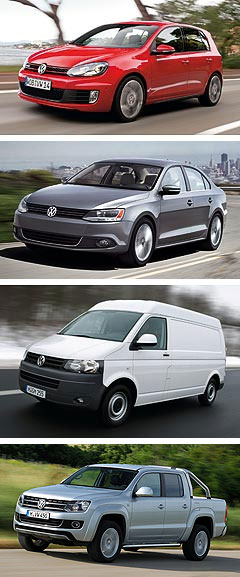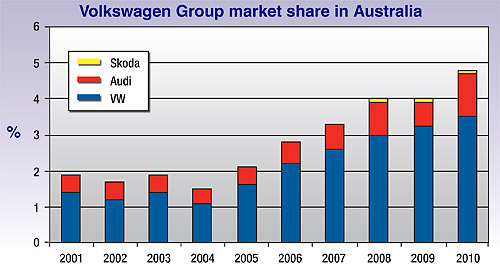Make / Model Search
News - VolkswagenThe second coming of VolkswagenMore models: Volkswagen has doubled its model range in Australia in the past decade with vehicles such as the Tiguan compact SUV. VW, the one-time star of the Australian market, makes another charge up the charts6 Aug 2010 NOT many people would remember that Volkswagen was once a powerhouse of the Australian motor industry. In 1958, the famous German brand even made the sales podium, coming third behind Holden and Ford on the strength of its popular first-generation Beetle, assembled – largely from bits imported from Germany – at its own factory in Clayton, Victoria, in a building, incidentally, later taken over by Nissan and now partly occupied by Holden Special Vehicles. Times changed and the Japanese onslaught of the 1970s relegated VW and its European mates to bit players in most markets outside their European stronghold. The wheel has turned again, however, and the people who brought you the ‘people’s car’ are once again on the march, looking for world prominence. They have even put a date on it – 2018 – by when they plan to give Toyota the heave-ho from the top of the world rankings. So far, the Wolfsburg company has marched past Fiat, Renault-Nissan, Chrysler and Ford and into third place. Second-placed General Motors, which is still struggling out of chapter 11 bankruptcy and still coming to terms with losing the number one position to Toyota, can now feel VW’s warm breath on the back of its neck. Last year, VW’s 10 brands – now including Porsche – pumped more than six million vehicles into the world’s garages. This year, global VW sales are up 16 per cent and on target to top seven million units. What’s more, VW is awash with cash, partly because of the profitability of its Audi luxury brand and also because of its massive presence in China.  From top: Volkswagen Golf GTI, Volkswagen Jetta, Volkswagen Transporter, Volkswagen Amarok. From top: Volkswagen Golf GTI, Volkswagen Jetta, Volkswagen Transporter, Volkswagen Amarok.In Australia, VW’s sales are up 21.5 per cent on the back of its new sixth-generation Golf – up 33.8 per cent – and the growing popularity of its Tiguan compact SUV (up 40.3 per cent) and Transporter van (up 32.2 per cent). But it is instructive to have a look back about 10 years to see how far the brand has come – and the trajectory it now appears to be on. Back in 2001, VW commanded just 1.4 per cent of the market. Luxury car-maker Mercedes-Benz, which has also had the benefit of commercial vehicles to bump up its sales figures, comfortably outsold VW in Australia, as did BMW. Back then, VW had nine models but was often described as the ‘Golf Car Company’ because of the dominance of its acclaimed hatchback that many people regard as the pioneer of the segment. The Golf spawned the ‘New Beetle’ and the Bora (now Jetta), but nothing much else made an impact. Gradually, VW has expanded its model range and ramped up its value for money. From 2005, under new VW Australia managing director Jutta Dierks, VW started its climb, growing its share year on year. While the arrival of the Touareg large SUV in 2004 stamped VW as a company willing to shake its boundaries, it did little to drive sales volume. The smaller Golf-based Tiguan, which hit Australia in 2008, did more, becoming VW’s third best-selling model after the Golf and mid-sized Passat. Now, VW offers twice as many models – 18 – as it did 10 years again, and while the Golf is still its dominating model (43 per cent), mainstream players such as the Polo light car are providing more strings to the bow – and critical acclaim. In the past two years, the strong Australian dollar and crumbling Euro has helped to give VW pricing the edge it needs against the Japanese car-makers. Part of this value equation comes from sourcing product from low-cost countries such as South Africa, although a brief dalliance with China was snuffed out and India seems to be off the agenda for now. The model expansion shows no sign of abating, with VW Australia warming up to enter the big-selling and highly competitive ute market with its Argentina-made Amarok next year, targeting a top-five LCV market position. By the end of 2012, VW Group plans to spend $22 billion on new model development, which is expected to include the company’s new Up! range of city cars, including electric and hybrid versions. Although Audi is imported by a separate channel in Australia, it too has mega plans globally, promising 15 new models by 2015. And just to show it has all the bases covered, VW’s budget manufacturer Skoda – which returned to Australia under the VW umbrella about three years ago and is still trying to find a toehold – is set to consolidate its position with new models – including the Yeti small SUV – over the next couple of years. While VW’s products have not always enjoyed the best of quality ratings, the public’s esteem for Volkswagen and its other brands – including Porsche and Lamborghini, although these, too, are imported through independent channels – has retained its lustre. Fellow mainstream European brands such Renault, Fiat and Citroen have mostly merely existed in Australia, but VW is showing it is made of sterner stuff. It is now a top 10 player with a 3.5 per cent share of the market, and if its other brands, Audi and Skoda were included, it would rival Honda and Subaru for market penetration. With huge plans for Asia, including China where it now has no fewer than 10 factories, VW is a brand to be watched as it sets out to stretch its market domination of Europe to the four corners of the globe – including Australia.  Read more14th of June 2010  VW to open 10th factory in ChinaAustralia off Chinese menu as VW eyes three million annual sales in four years11th of June 2010  A1 to drive a million Audi salesAudi expects its smallest model ever to drive 2010 sales back past the million mark23rd of March 2010  VW targets top-five rank in commercial salesFacelifted T5, new Amarok and 2011 Caddy to ramp up VW’s commercials to new level |
Click to shareVolkswagen articlesResearch Volkswagen Motor industry news |











Facebook Twitter Instagram